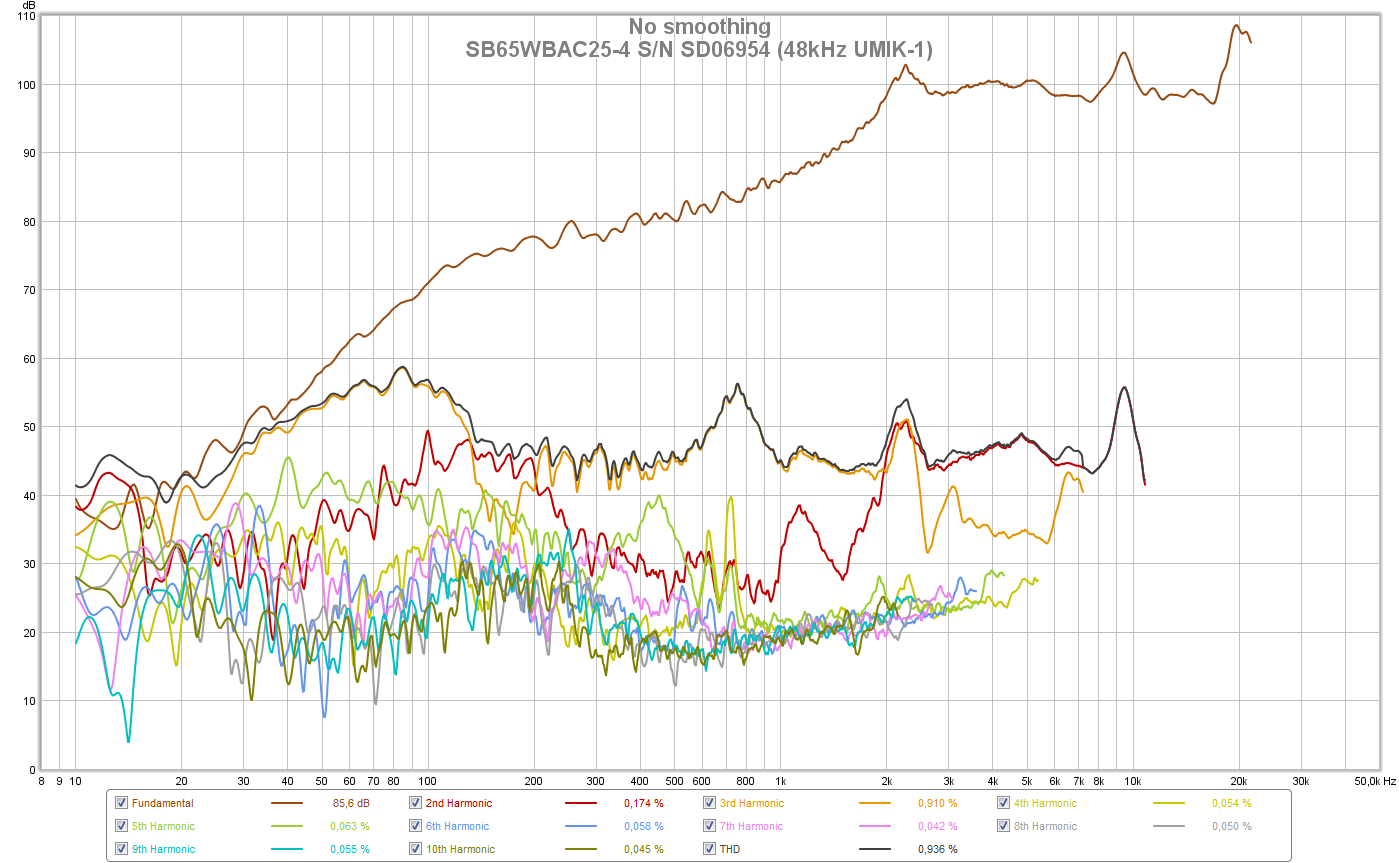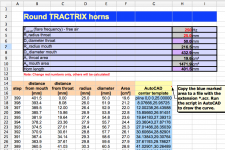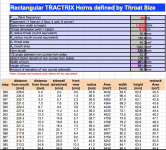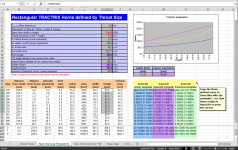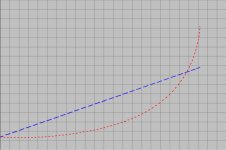1)The 2384 is 30" wide, bigger than the "bookshelf" size this thread refers to, and the 2432 is a 3" diaphragm compression driver, as opposed to the cone drivers being used in this thread. Woofers certainly could be added to the JBL 2432/2384 combination, though the curved surfaces do complicate woofer mounting compared to the use of a conical horn.1)Would this work with a jbl 2432 compression driver in a 2384 horn?
2)What would you recommend for the mid woofer?
3)Would Dual 8in be sufficient ?
4)How do you calculate the location of the woofer injection ports? As near as possible to the throat?
2)The recommendation would depend on how low and loud you want them to go, and how much cabinet volume you are willing to use. Some DIY builders have used 15" with similar horn/driver combinations.
3)"Sufficient" is hard to quantify. The 2432 will go louder than a pair of 8" with an acoustical crossover around 1000 Hz, and easily keep up with a pair of 10" with 6mm Xmax with the acoustical crossover around 900 Hz. The 2432/2384 combination is used above two 15" crossed as low as 630 Hz for cinema applications.
4) Practically speaking, locating the woofers as near as possible to the throat will give the best results.
Art
Last edited:
That 2384 looks interesting - it has the pinched walls for better patter control. The pinched walls make it not a flat wall horn but still doable with bass injection. You might even be able to fit a pair of 12 inch drivers on the walls for the band pass injection. Certainly will not be bookshelf anymore and a 30in wide mouth makes it on same scale as many conventional synergies. I don't know what the throat size is but if 2in then a 3.5in driver like the SS 10F could be used.
http://www.jblpro.com/pub/cinema/4622.pdf
http://www.jblpro.com/pub/cinema/4622.pdf
The JBL 2384 uses a 1.5" throat, a 3.5" cone driver is too large, resulting in a serious HF notch in the 4kHz range response.I don't know what the throat size is but if 2in then a 3.5in driver like the SS 10F could be used.
Ideally, the horn throat should be the diameter of the cone plus about 1/2 the surround diameter.
2in full range drivers then. Or 2.5in with an adapter as I have done with the SB65WBAC15-4. Maybe Tang Band W2-852SH? Or Vifa TC6FD.
Thanks for all the feedback! I managed to get the 2384 horn together with the 2432 CD, so I'm looking at options for woofers.
Regarding size and keeping up, this will be used indoors in a home theater LCR, so perhaps 2x 8in or 2x10in should be sufficient for the application?
How do I go about selecting or shortlisting woofers? What are the important criteria for the bandpass injection? I'd like to be able to achieve 30hz if possible. Should I be looking at hifi or pro audio woofers?
Regarding xo frequency, is the lower the better?
Sent from my GT-I9505 using Tapatalk
Regarding size and keeping up, this will be used indoors in a home theater LCR, so perhaps 2x 8in or 2x10in should be sufficient for the application?
How do I go about selecting or shortlisting woofers? What are the important criteria for the bandpass injection? I'd like to be able to achieve 30hz if possible. Should I be looking at hifi or pro audio woofers?
Regarding xo frequency, is the lower the better?
Sent from my GT-I9505 using Tapatalk
Regarding pattern control, these are from the 4722 datasheet. For a 30in wide waveguide, it doesn't seem to hold pattern that much lower than the 18sound 1464.
Also, it's got a much wider beam width, about 100 degrees, compared to 60 degrees on the 18sound.
JBL 2384
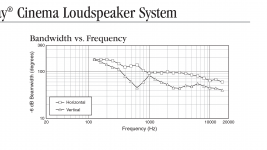
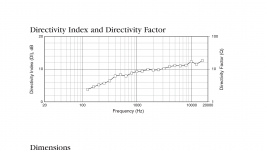
18sound 1464


Sent from my GT-I9505 using Tapatalk
Also, it's got a much wider beam width, about 100 degrees, compared to 60 degrees on the 18sound.
JBL 2384


18sound 1464


Sent from my GT-I9505 using Tapatalk
Last edited:
I have run many sims with a bunch of pro and hifi woofers and it turns out that the SB29SNRX45-8 that Bushmeister is using is the best option of you want to reach 30Hz with low distortion. It has the right balance of everything and very low distortion. Pro woofers tend to have too high of an fs and to low of a Qts that bass extension will not be as good.
Thanks- I'll look up the SB29 woofer. Does it come in a 10in model?
How do I simulate the woofer in the bandpass enclosure, with the offset injection into the horn? Using offset horn model in horn response? How do I approximate the flare of the 2384 horn that I'm using?
Sent from my GT-I9505 using Tapatalk
How do I simulate the woofer in the bandpass enclosure, with the offset injection into the horn? Using offset horn model in horn response? How do I approximate the flare of the 2384 horn that I'm using?
Sent from my GT-I9505 using Tapatalk
Thanks, Google caught that when I looked it up Haha.rhapsodee,
Think SB29SNRX45-8 is a typo bushmeister run dual SB23NRXS45-8 : )
X,
Is the dayton rs225 comparable? You're using the rs180 correct?
Sent from my GT-I9505 using Tapatalk
Haha good catch Byrtt. 🙂
To simulate a bandpass I use Akabak and the horn profile was taken from 5 cross sectional ellipse measurments from Bushmeister.
The bass bandpass injection will not be that critical to get the horn profile exact as not much horn gain is happening.
Just a 2 or 3 segment approx in HR can work.
To simulate a bandpass I use Akabak and the horn profile was taken from 5 cross sectional ellipse measurments from Bushmeister.
The bass bandpass injection will not be that critical to get the horn profile exact as not much horn gain is happening.
Just a 2 or 3 segment approx in HR can work.
Thanks, Google caught that when I looked it up Haha.
X,
Is the dayton rs225 comparable? You're using the rs180 correct?
Sent from my GT-I9505 using Tapatalk
Hi all
I would like to point out to you a couple of alternatives to SB23 woofer that I think can work too very well in this design.
Or maybe for anyone is useful for something other thing.
I also believe they have good value for money, at least if buying in Europe or better in Spain 😀 .
Sure there are many more suitable.
8 "
https://www.beyma.com/getpdf.php?pid=8BR40/N
* 10 "
http://www.beyma.com/getpdf.php?pid=10BR60/V2
http://www.beyma.com/getpdf.php?pid=10G40
But I think for sure with that ss revelator (if you want to spend all your money 🙂 )
http://www.scan-speak.dk/datasheet/pdf/26w-4867t00.pdf
if you can give it enougth "breath" in the enclosure for his VAS.
Regards
Jose
Last edited:
The Daytons will not be as good as the SB23 I think. I know the RS180P does not have the same performance and I fear that the RS225 will still not be able to keep up with the ultra low distortion performance (although I have not tried it).
The Beyma 8in above looks like a good candidate though.
The Beyma 8in above looks like a good candidate though.
Got my new driver and it is much better!.....
Nice agreement between those two drivers, have best operation mod frame mod and get it into duty.
I saw this paper, maybe interesting for making a horn, and yes X here she explane the way a horn works
in HF, it needs correction, but after the mid, so making correction feasable.
Very interesting paper of a constant directivity horn, and after 3 Khz a fall off 6dB octave as happening with the tractrix. However, this horn with A T-tube can be interesting because the T-tube is wide like this type of horn.
regards
in HF, it needs correction, but after the mid, so making correction feasable.
Very interesting paper of a constant directivity horn, and after 3 Khz a fall off 6dB octave as happening with the tractrix. However, this horn with A T-tube can be interesting because the T-tube is wide like this type of horn.
regards
Attachments
Kees,
Thanks for the tip on the paper by EV - very useful info. I have noticed that the very small pinch that the tractrix has in the initial channel when using the tractix calculator provided by E. Forker (Volvotreter) is not always present in commercial "tractrix" designs I wonder if this pinch improves the efficiency?
Dinsdale paper (Wireless World) on horns:
http://www.volvotreter.de/downloads/Dinsdale_Horns_1.pdf
https://en.wikipedia.org/wiki/Tractrix
Thanks for the tip on the paper by EV - very useful info. I have noticed that the very small pinch that the tractrix has in the initial channel when using the tractix calculator provided by E. Forker (Volvotreter) is not always present in commercial "tractrix" designs I wonder if this pinch improves the efficiency?
Dinsdale paper (Wireless World) on horns:
http://www.volvotreter.de/downloads/Dinsdale_Horns_1.pdf
https://en.wikipedia.org/wiki/Tractrix
An externally hosted image should be here but it was not working when we last tested it.
Last edited:
The "pinch" in Volvotreter's rectangular Tractrix calculator is needed for the cross sectional area to continuously expand from the throat to the mouth according to the Tractrix horn profile while using two straight sides and two curved sides.I have noticed that the very small pinch that the tractrix has in the initial channel when using the tractix calculator provided by E. Forker (Volvotreter) is not always present in commercial "tractrix" designs I wonder if this pinch improves the efficiency?
Without the reduction in width, the throat expansion would be more rapid (like a conical), which would reduce efficiency. The circular expansion does not require a pinch to conform to the Tractrix horn profile.
The pinched throats used in many constant directivity horn designs are not used to increase efficiency, but to reduce the width to less than a wavelength of the highest frequency so the wave will diffract and "fill" the horn to eliminate HF beaming.
Attachments
Last edited:
The "pinch" in Volvotreter's rectangular tractrix calculator is needed for the cross sectional area to continuously expand from the throat to the mouth while using two straight sides and two curved sides. There is no pinch when using a circular expansion.
The pinched throats used in many horn designs are not used to increase efficiency, but to reduce the width to less than a wavelength of the highest frequency so the wave will diffract and "fill" the horn to eliminate HF beaming.
Weltersys,
That appears to be the simplified version of the spreadsheet with less resolution. I used the original v1.2a with more fidelity and it has the following output for a 300Hz horn with the 3.5cm throat. There is a small pinch in the curved wall as shown by the highlighted box. Although, the overall cross sectional area still increases, I guess this has to do with fact that one set of walls are flat and expanding.
The original spreadsheet is here:
http://www.volvotreter.de/downloads/tractrix_v1.3a.xls.zip
Here is a screenshot of the spreadsheet:
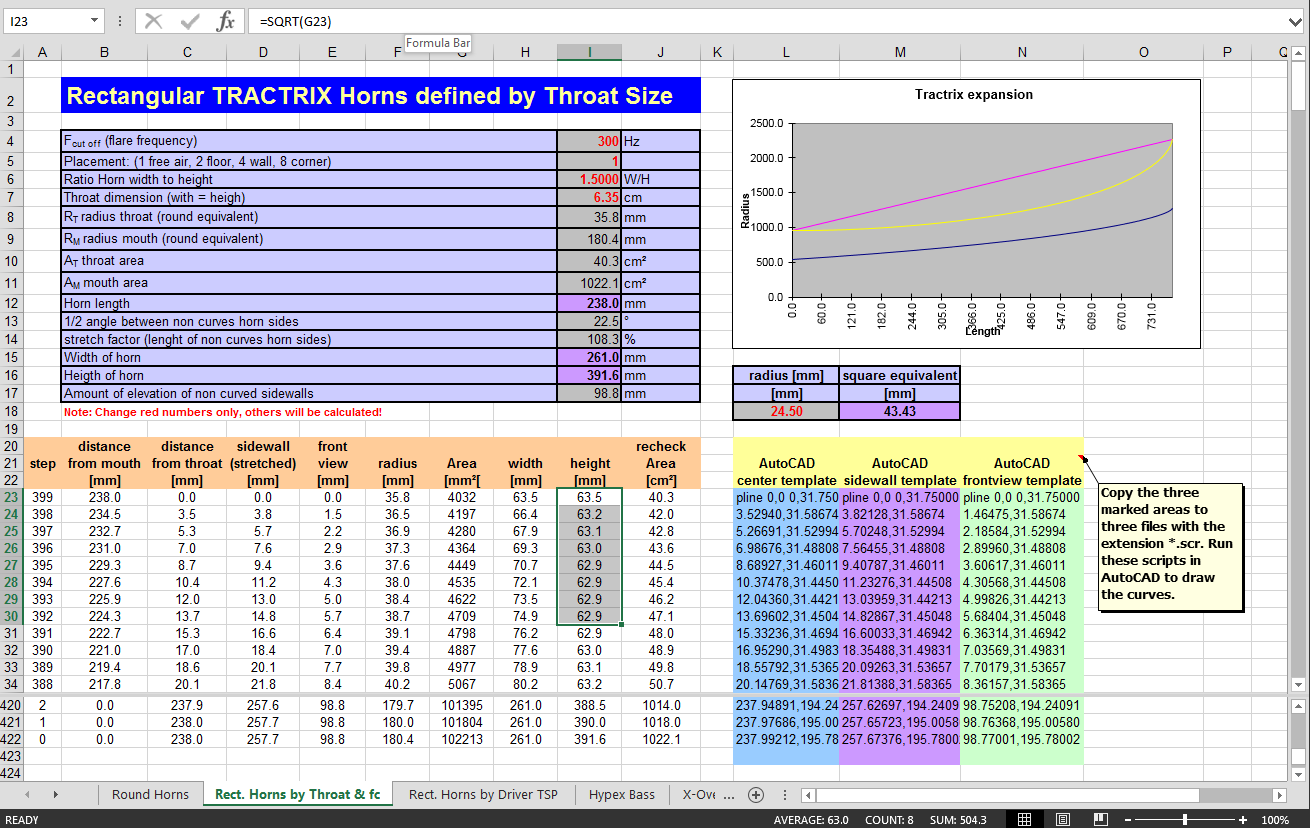
And if you plot it you can see the slight pinch. So when I build them, it starts at the driver throat with a very mild contraction for a few inches then expands:
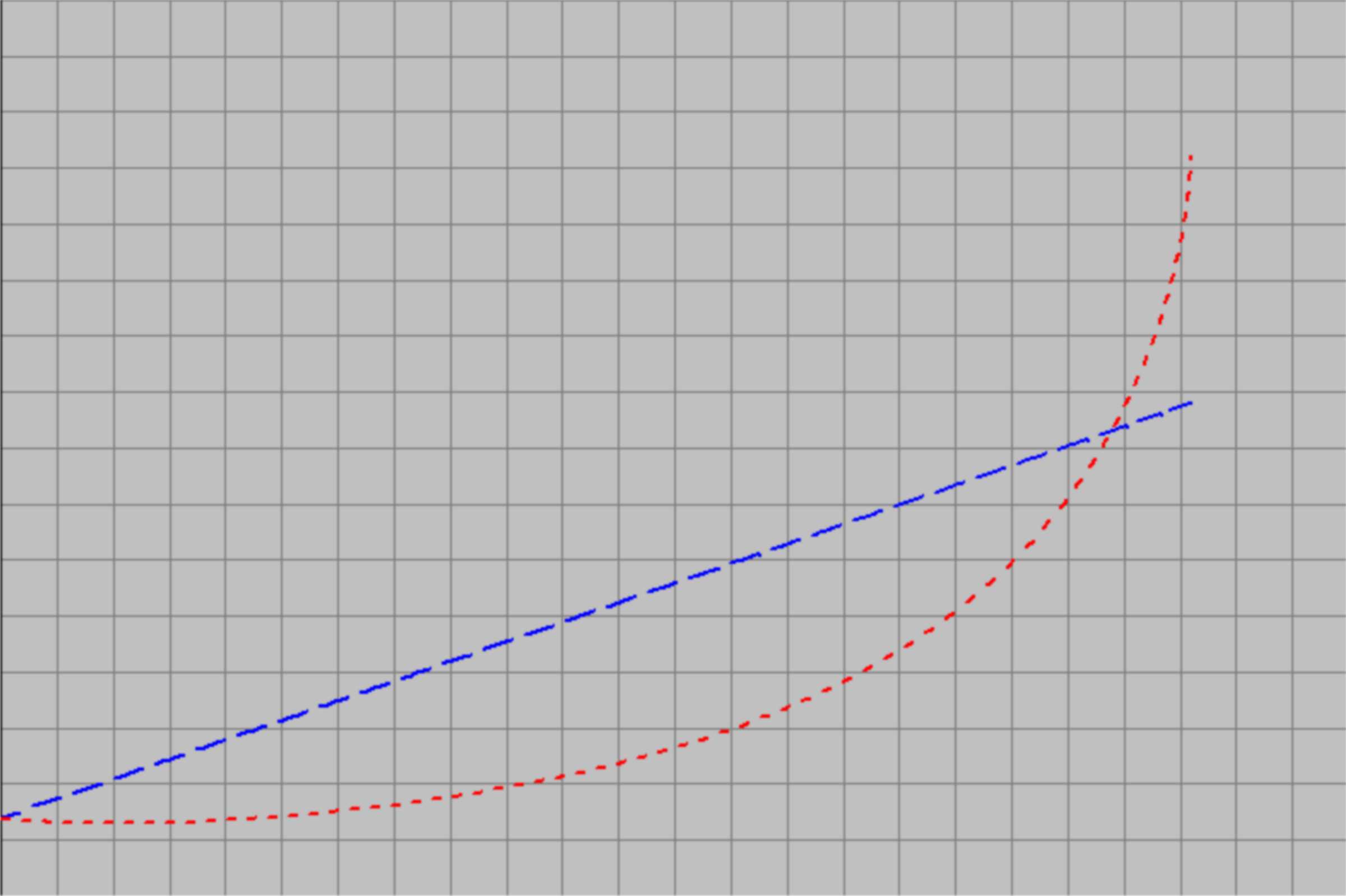
The above is the actual plot I used as an overlay to superimpose a single spline function in SolidWorks to replicate the tractrix mathematically without entering the complex function in the solid model.
Attachments
Last edited:
- Home
- Loudspeakers
- Multi-Way
- A Bookshelf Multi-Way Point-Source Horn
